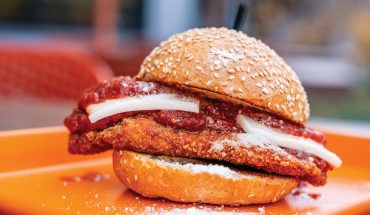by Kaitlyn Goalen
photographs by Jillian Clark
Most enthusiastic cooks I know have an ingredient that they love to experiment with, something that allows them an exit ramp off the highway of cooking routines. For me, that ingredient is chile peppers.
During my childhood, our pepper supply didn’t go much further than ground cayenne in a canister and the occasional jalapeño. Then, around my freshman year of college, I purchased the cookbook of one of my favorite Los Angeles chefs at the time, Suzanne Goin. Nearly every single one of her recipes in Sunday Suppers at Lucques called for chile de arbol, with the same reflexive comfort that most cooks call for salt and black pepper. At the time, I couldn’t find it in any of my nearby grocery stores, and the search for it became a minor obsession.
Finally, I walked into a Latin grocery store and there it was, right in front of me, along a wall with approximately 20 other types of chiles, most of which I’d never heard of. I stocked up on the chiles de arbol, in both fresh and dried form, and then loaded my basket with as many other types that I could find.
It was the entrance to a rabbit hole. A trip to the nearest Asian market provided another wall of chiles, all different. Soon my web history was filled with searches for chiles from every possible corner of the world: cascabels, piri piri, aji dulce, aji amarillo, four types of paprika, scotch bonnets, urfa biber. It’s a habit that I’ve continued, such that now I have an entire shelf of my pantry devoted to chiles. And the daunting task of figuring out how to use them.
But there’s good news on that front. One of the reasons why every possible food culture seems to make room for chiles is because they are the kitchen version of a Swiss Army Knife: endlessly adaptable, easily preserved, and globally indispensable. Flavor-wise, the first, most obvious profile of chiles is heat. But beyond that, they can contribute a fruity, yet savory flavor; acid; sweetness; even smoke. What other vegetable has the potential for all that?
Preservation-wise, they make a killer pickle, are easily dried for later use, ground into powder, and of course, made into hot sauce – arguably the world’s most beloved and ubiquitous condiment.
And recipe-wise, there’s no end to what you can do with them. By focusing on chiles, my repertoire has opened up dramatically, with forays into Tex-Mex-style chile gravy for enchiladas, sharply spicy green papaya salads, Indian biryanis and vindaloos, chicken paprikash (invented by Hungary, embraced by the Midwest).
Our region has all the right features for growing this late summer crop, and as a result, the farmers market booms with yellow, orange, red, and green chile peppers this time of year: Jalapeños and habaneros with far more crunch and heat than the supermarket version, plus a wellspring of lesser-known quantities, such as lunch box peppers, sweet cubanelles, pimenta de cheiros, sweet bananas, shishitos, cayennes, and more.
If you’re not sure where to start, consider this recipe for stuffed pepper (below). What looks like a basic and familiar jalapeño popper has three layers of chiles: a harissa-style pepper paste, minced pickled peppers, and then the peppers that act as vessels for the filling. The two base recipes will serve you in endless additional capacities, so consider doubling up on the recipe.
Tri-Ply Jalapeño Poppers
Makes 30, with leftover pepper paste and pickled peppers
For the pickled peppers:
2 cups hot chile peppers (such as jalapeños, chiles de arbol, or Thai bird chiles)
3 garlic cloves
¼ teaspoon mustard seeds
¼ teaspoon coriander seeds
½ teaspoon black peppercorns
1 cup cider vinegar
¼ cup sugar
2 tablespoons kosher salt
For the pepper paste:
4 ounces dried peppers – a mix of smoky (like morita, ancho, or urfa biber) and fruity (like New Mexico or pasilla)
1 large bell pepper
2 tablespoons tomato paste
2 garlic cloves
1 teaspoon salt
2 tablespoons neutral vegetable oil
For the poppers:
One 8-ounce block cream cheese, at room temperature
2 cups shredded sharp cheddar
¼ cup minced scallions
¼ cup minced cilantro
1 tablespoon pepper paste (see above)
2 tablespoons minced pickled peppers, plus 1 tablespoon of the leftover pickling liquid (see above)
½ cup diced tomato
15 jalapeños
Make the pickled peppers: Trim and discard the stems from the peppers and cut into rings. Loosely pack the pepper rings into a pint jar, along with the garlic, mustard seeds, coriander seeds, and peppercorns. In a medium saucepan, combine the vinegar, sugar, salt, and 1 cup water. Bring to a boil, so that the sugar and salt dissolve. Pour the warm liquid over the peppers, cover, and let sit for at least 4 hours (preferably overnight) before using. The pickles will keep in the refrigerator for 4 weeks.
Make the pepper spread: Place the dried peppers in a medium bowl, and cover with hot water. Let sit for 20 minutes, until they are softened. Drain, remove the stems, and transfer the peppers to a food processor.
Preheat the broiler, and arrange the oven rack close to the broiler element. Place the red pepper on a foil-lined baking sheet and broil until the pepper’s skin is dark all over and the pepper is deflated, rotating with tongs throughout, about 15 minutes total. Transfer the pepper to a metal bowl, and cover tightly with plastic wrap. Let steam for 15 minutes. Carefully remove the skin, seeds, and stem of the pepper, and place the flesh in a food processor with the rehydrated chiles. Add the tomato paste, garlic, salt, and oil, and process until smooth. The pepper paste will keep in a lidded container for 2 weeks.
Make the poppers: Preheat the oven to 350 degrees. In a large bowl, combine the cream cheese, cheddar cheese, scallions, cilantro, pepper paste, pickled peppers with their liquid, and tomato until well combined. Remove the stems from the jalapeños, and slice them in half lengthwise. Use a spoon to scrape out the seeds and inner membranes, then fill each pepper half with some of the filling. Place the filled pepper halves on a foil-lined baking sheet and bake for 18-to-20 minutes, until the peppers are softened and the filling is golden-brown in spots. Let cool slightly, then serve warm.





